Taxation Theory, Practice & Law Assignment: Analysis of Tax Principles
VerifiedAdded on 2020/04/07
|9
|2420
|389
Report
AI Summary
This report provides a comprehensive analysis of several key areas within Australian taxation law. It begins by addressing capital gains tax, illustrating the computation of capital gains and losses based on different holding periods of assets. The report then delves into fringe benefits tax, specifically examining a scenario involving a loan provided to an employee and calculating the taxable value of the fringe benefit. The analysis continues with a discussion of loss allocation in rental property situations, considering the implications of agreements between joint tenants. Furthermore, the report explores the principle established in IRC v Duke of Westminster [1936] AC 1, evaluating its relevance in the Australian context, and discusses tax avoidance. Finally, the report examines the taxation of income derived from timber, considering scenarios involving the sale of timber and the granting of rights to remove timber from land. The report concludes with a list of references used to support the analysis.
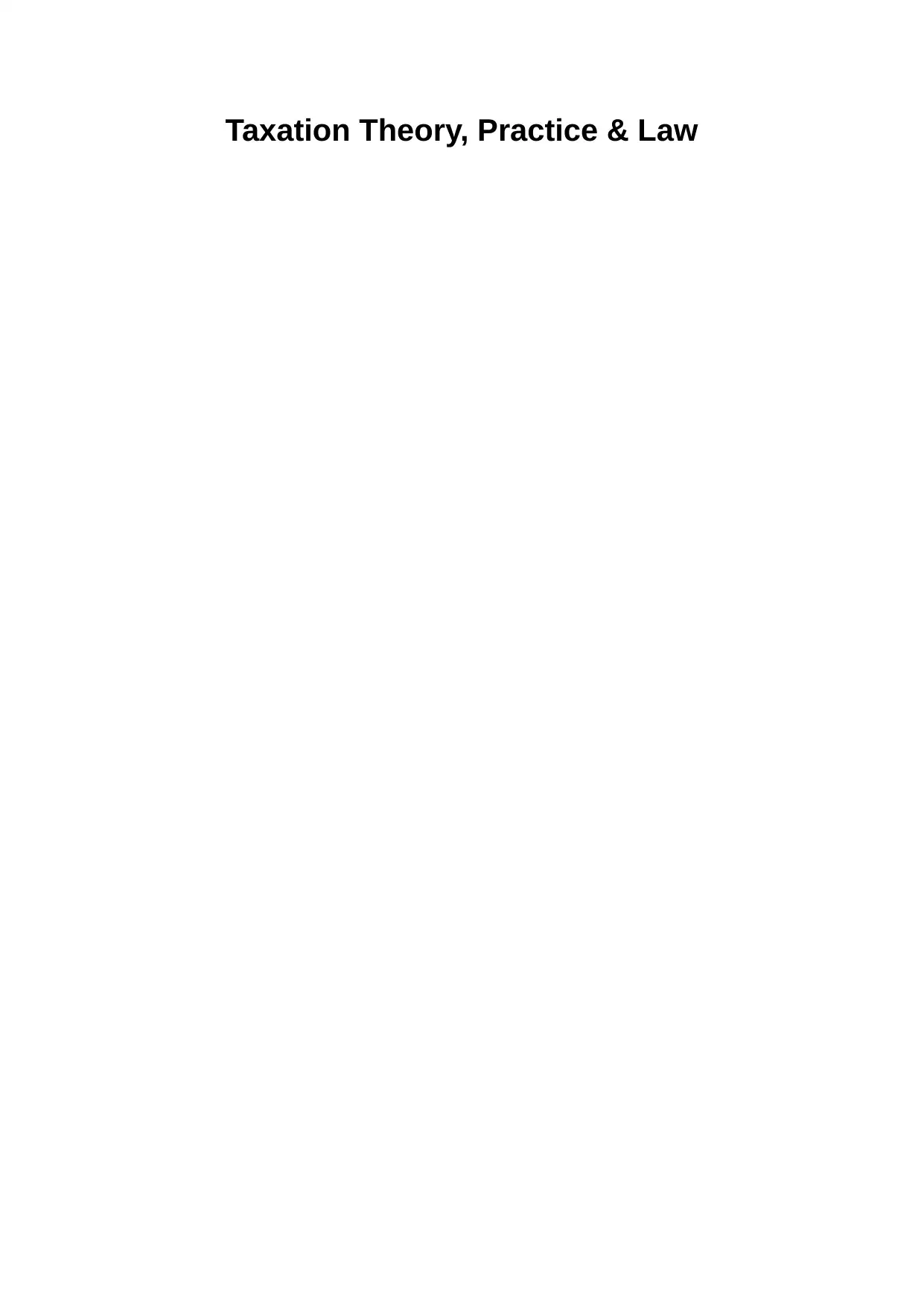
Taxation Theory, Practice & Law
Paraphrase This Document
Need a fresh take? Get an instant paraphrase of this document with our AI Paraphraser

TABLE OF CONTENTS
Question 1..................................................................................................................................3
Issue........................................................................................................................................3
Legal provisions for taxation.................................................................................................3
Application and conclusion....................................................................................................3
Question 2..................................................................................................................................3
Issue........................................................................................................................................3
Legal provisions for taxation.................................................................................................3
Application and conclusion....................................................................................................3
Question 3..................................................................................................................................3
Issue........................................................................................................................................3
Legal provisions for taxation.................................................................................................3
Application and conclusion....................................................................................................3
Question 4..................................................................................................................................3
Principle established in IRC v Duke of Westminster [1936] AC 1.......................................3
Relevance of this principal in Australia.................................................................................3
Question 5..................................................................................................................................3
Issue........................................................................................................................................3
Legal provisions for taxation.................................................................................................3
Application and conclusion....................................................................................................3
References..................................................................................................................................4
Question 1..................................................................................................................................3
Issue........................................................................................................................................3
Legal provisions for taxation.................................................................................................3
Application and conclusion....................................................................................................3
Question 2..................................................................................................................................3
Issue........................................................................................................................................3
Legal provisions for taxation.................................................................................................3
Application and conclusion....................................................................................................3
Question 3..................................................................................................................................3
Issue........................................................................................................................................3
Legal provisions for taxation.................................................................................................3
Application and conclusion....................................................................................................3
Question 4..................................................................................................................................3
Principle established in IRC v Duke of Westminster [1936] AC 1.......................................3
Relevance of this principal in Australia.................................................................................3
Question 5..................................................................................................................................3
Issue........................................................................................................................................3
Legal provisions for taxation.................................................................................................3
Application and conclusion....................................................................................................3
References..................................................................................................................................4
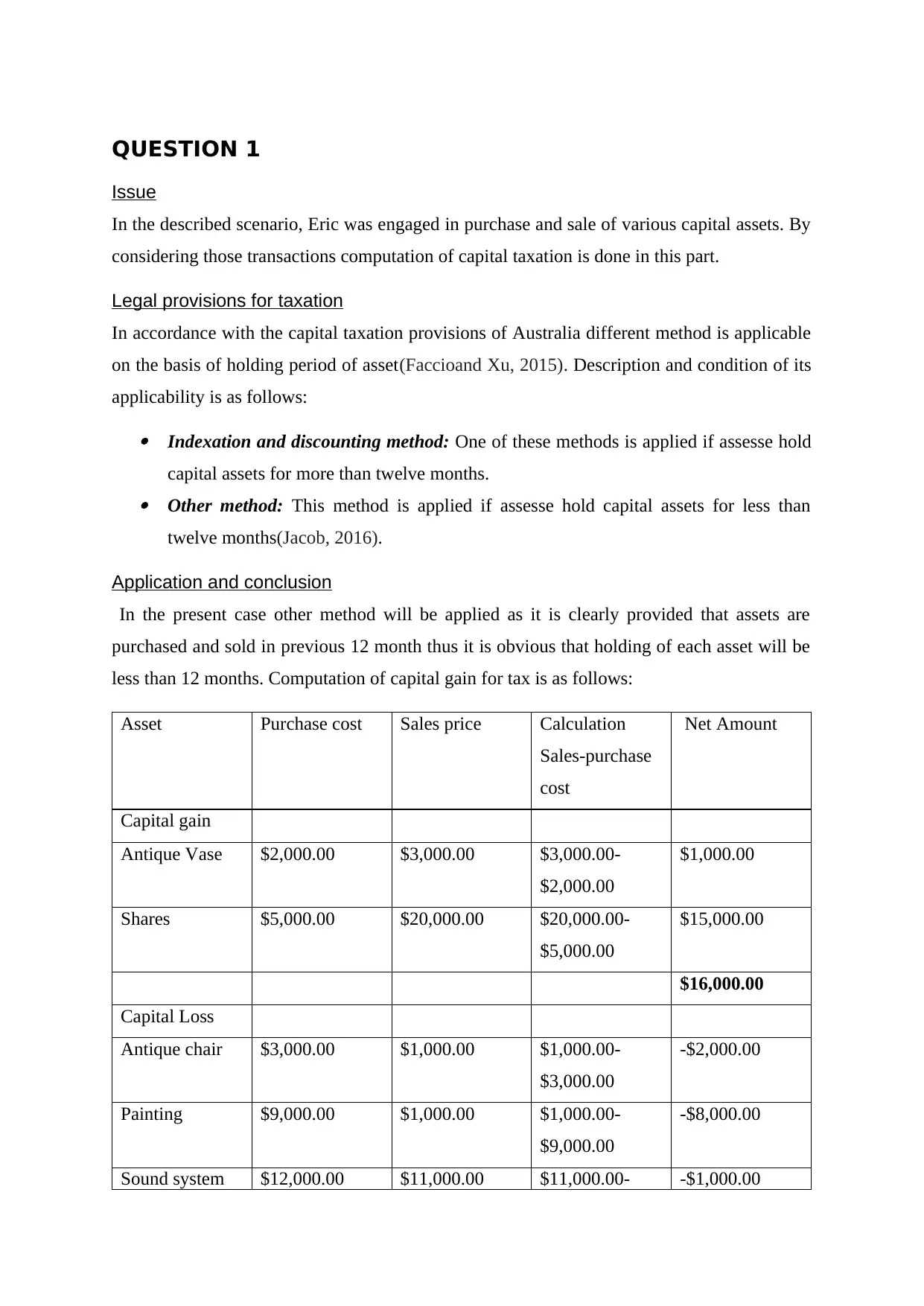
QUESTION 1
Issue
In the described scenario, Eric was engaged in purchase and sale of various capital assets. By
considering those transactions computation of capital taxation is done in this part.
Legal provisions for taxation
In accordance with the capital taxation provisions of Australia different method is applicable
on the basis of holding period of asset(Faccioand Xu, 2015). Description and condition of its
applicability is as follows: Indexation and discounting method: One of these methods is applied if assesse hold
capital assets for more than twelve months. Other method: This method is applied if assesse hold capital assets for less than
twelve months(Jacob, 2016).
Application and conclusion
In the present case other method will be applied as it is clearly provided that assets are
purchased and sold in previous 12 month thus it is obvious that holding of each asset will be
less than 12 months. Computation of capital gain for tax is as follows:
Asset Purchase cost Sales price Calculation
Sales-purchase
cost
Net Amount
Capital gain
Antique Vase $2,000.00 $3,000.00 $3,000.00-
$2,000.00
$1,000.00
Shares $5,000.00 $20,000.00 $20,000.00-
$5,000.00
$15,000.00
$16,000.00
Capital Loss
Antique chair $3,000.00 $1,000.00 $1,000.00-
$3,000.00
-$2,000.00
Painting $9,000.00 $1,000.00 $1,000.00-
$9,000.00
-$8,000.00
Sound system $12,000.00 $11,000.00 $11,000.00- -$1,000.00
Issue
In the described scenario, Eric was engaged in purchase and sale of various capital assets. By
considering those transactions computation of capital taxation is done in this part.
Legal provisions for taxation
In accordance with the capital taxation provisions of Australia different method is applicable
on the basis of holding period of asset(Faccioand Xu, 2015). Description and condition of its
applicability is as follows: Indexation and discounting method: One of these methods is applied if assesse hold
capital assets for more than twelve months. Other method: This method is applied if assesse hold capital assets for less than
twelve months(Jacob, 2016).
Application and conclusion
In the present case other method will be applied as it is clearly provided that assets are
purchased and sold in previous 12 month thus it is obvious that holding of each asset will be
less than 12 months. Computation of capital gain for tax is as follows:
Asset Purchase cost Sales price Calculation
Sales-purchase
cost
Net Amount
Capital gain
Antique Vase $2,000.00 $3,000.00 $3,000.00-
$2,000.00
$1,000.00
Shares $5,000.00 $20,000.00 $20,000.00-
$5,000.00
$15,000.00
$16,000.00
Capital Loss
Antique chair $3,000.00 $1,000.00 $1,000.00-
$3,000.00
-$2,000.00
Painting $9,000.00 $1,000.00 $1,000.00-
$9,000.00
-$8,000.00
Sound system $12,000.00 $11,000.00 $11,000.00- -$1,000.00
⊘ This is a preview!⊘
Do you want full access?
Subscribe today to unlock all pages.

Trusted by 1+ million students worldwide
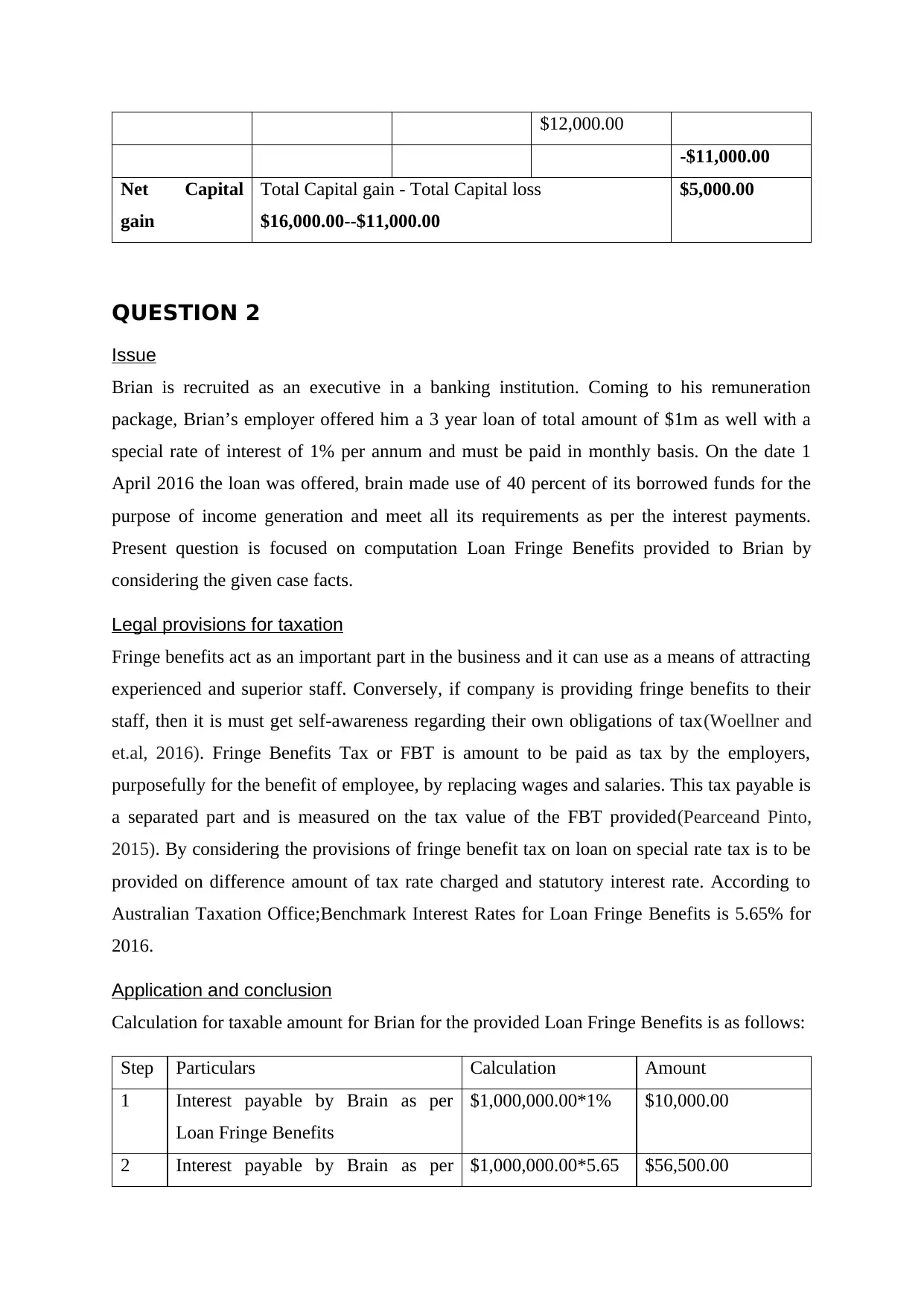
$12,000.00
-$11,000.00
Net Capital
gain
Total Capital gain - Total Capital loss
$16,000.00--$11,000.00
$5,000.00
QUESTION 2
Issue
Brian is recruited as an executive in a banking institution. Coming to his remuneration
package, Brian’s employer offered him a 3 year loan of total amount of $1m as well with a
special rate of interest of 1% per annum and must be paid in monthly basis. On the date 1
April 2016 the loan was offered, brain made use of 40 percent of its borrowed funds for the
purpose of income generation and meet all its requirements as per the interest payments.
Present question is focused on computation Loan Fringe Benefits provided to Brian by
considering the given case facts.
Legal provisions for taxation
Fringe benefits act as an important part in the business and it can use as a means of attracting
experienced and superior staff. Conversely, if company is providing fringe benefits to their
staff, then it is must get self-awareness regarding their own obligations of tax(Woellner and
et.al, 2016). Fringe Benefits Tax or FBT is amount to be paid as tax by the employers,
purposefully for the benefit of employee, by replacing wages and salaries. This tax payable is
a separated part and is measured on the tax value of the FBT provided(Pearceand Pinto,
2015). By considering the provisions of fringe benefit tax on loan on special rate tax is to be
provided on difference amount of tax rate charged and statutory interest rate. According to
Australian Taxation Office;Benchmark Interest Rates for Loan Fringe Benefits is 5.65% for
2016.
Application and conclusion
Calculation for taxable amount for Brian for the provided Loan Fringe Benefits is as follows:
Step Particulars Calculation Amount
1 Interest payable by Brain as per
Loan Fringe Benefits
$1,000,000.00*1% $10,000.00
2 Interest payable by Brain as per $1,000,000.00*5.65 $56,500.00
-$11,000.00
Net Capital
gain
Total Capital gain - Total Capital loss
$16,000.00--$11,000.00
$5,000.00
QUESTION 2
Issue
Brian is recruited as an executive in a banking institution. Coming to his remuneration
package, Brian’s employer offered him a 3 year loan of total amount of $1m as well with a
special rate of interest of 1% per annum and must be paid in monthly basis. On the date 1
April 2016 the loan was offered, brain made use of 40 percent of its borrowed funds for the
purpose of income generation and meet all its requirements as per the interest payments.
Present question is focused on computation Loan Fringe Benefits provided to Brian by
considering the given case facts.
Legal provisions for taxation
Fringe benefits act as an important part in the business and it can use as a means of attracting
experienced and superior staff. Conversely, if company is providing fringe benefits to their
staff, then it is must get self-awareness regarding their own obligations of tax(Woellner and
et.al, 2016). Fringe Benefits Tax or FBT is amount to be paid as tax by the employers,
purposefully for the benefit of employee, by replacing wages and salaries. This tax payable is
a separated part and is measured on the tax value of the FBT provided(Pearceand Pinto,
2015). By considering the provisions of fringe benefit tax on loan on special rate tax is to be
provided on difference amount of tax rate charged and statutory interest rate. According to
Australian Taxation Office;Benchmark Interest Rates for Loan Fringe Benefits is 5.65% for
2016.
Application and conclusion
Calculation for taxable amount for Brian for the provided Loan Fringe Benefits is as follows:
Step Particulars Calculation Amount
1 Interest payable by Brain as per
Loan Fringe Benefits
$1,000,000.00*1% $10,000.00
2 Interest payable by Brain as per $1,000,000.00*5.65 $56,500.00
Paraphrase This Document
Need a fresh take? Get an instant paraphrase of this document with our AI Paraphraser
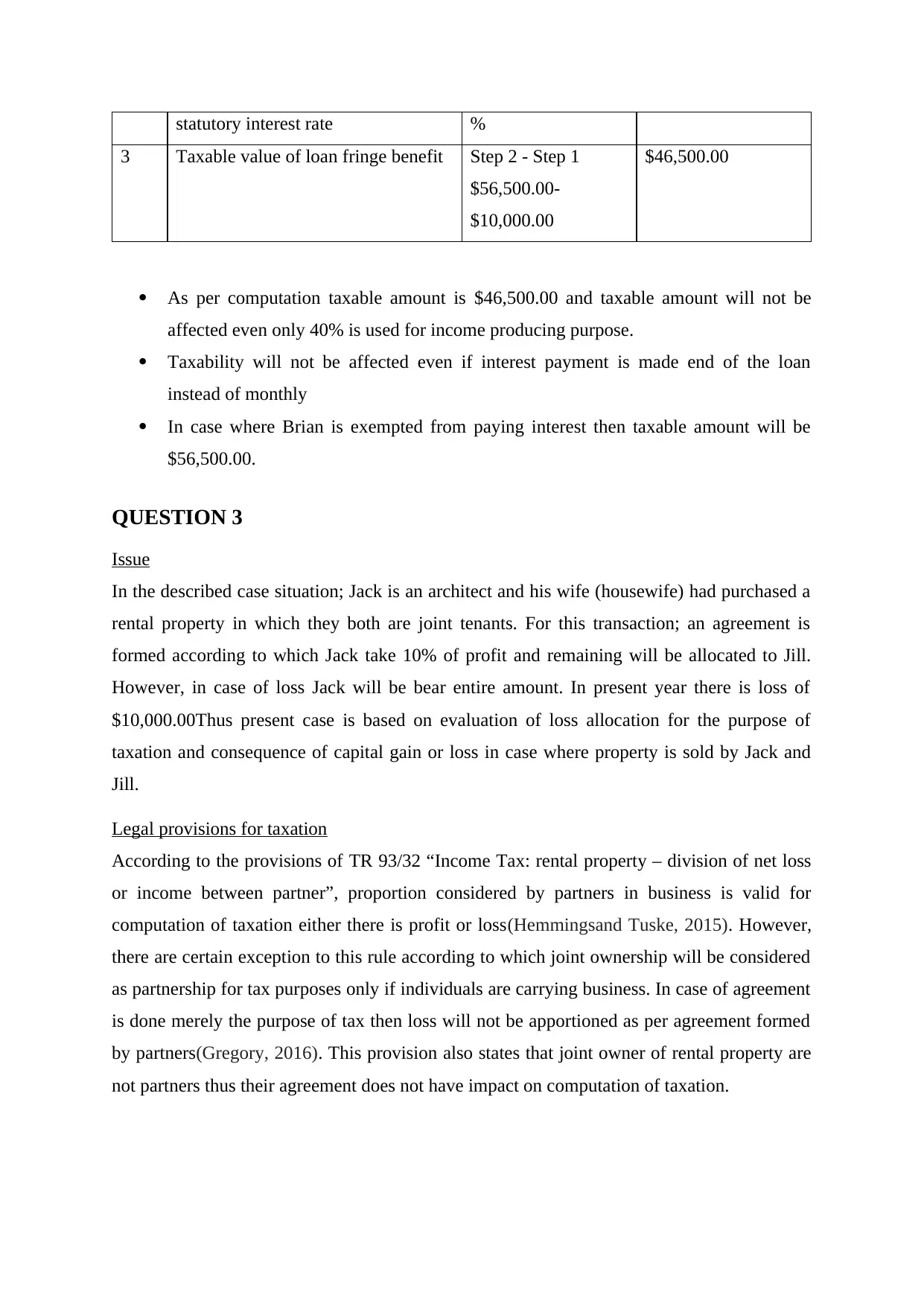
statutory interest rate %
3 Taxable value of loan fringe benefit Step 2 - Step 1
$56,500.00-
$10,000.00
$46,500.00
As per computation taxable amount is $46,500.00 and taxable amount will not be
affected even only 40% is used for income producing purpose.
Taxability will not be affected even if interest payment is made end of the loan
instead of monthly
In case where Brian is exempted from paying interest then taxable amount will be
$56,500.00.
QUESTION 3
Issue
In the described case situation; Jack is an architect and his wife (housewife) had purchased a
rental property in which they both are joint tenants. For this transaction; an agreement is
formed according to which Jack take 10% of profit and remaining will be allocated to Jill.
However, in case of loss Jack will be bear entire amount. In present year there is loss of
$10,000.00Thus present case is based on evaluation of loss allocation for the purpose of
taxation and consequence of capital gain or loss in case where property is sold by Jack and
Jill.
Legal provisions for taxation
According to the provisions of TR 93/32 “Income Tax: rental property – division of net loss
or income between partner”, proportion considered by partners in business is valid for
computation of taxation either there is profit or loss(Hemmingsand Tuske, 2015). However,
there are certain exception to this rule according to which joint ownership will be considered
as partnership for tax purposes only if individuals are carrying business. In case of agreement
is done merely the purpose of tax then loss will not be apportioned as per agreement formed
by partners(Gregory, 2016). This provision also states that joint owner of rental property are
not partners thus their agreement does not have impact on computation of taxation.
3 Taxable value of loan fringe benefit Step 2 - Step 1
$56,500.00-
$10,000.00
$46,500.00
As per computation taxable amount is $46,500.00 and taxable amount will not be
affected even only 40% is used for income producing purpose.
Taxability will not be affected even if interest payment is made end of the loan
instead of monthly
In case where Brian is exempted from paying interest then taxable amount will be
$56,500.00.
QUESTION 3
Issue
In the described case situation; Jack is an architect and his wife (housewife) had purchased a
rental property in which they both are joint tenants. For this transaction; an agreement is
formed according to which Jack take 10% of profit and remaining will be allocated to Jill.
However, in case of loss Jack will be bear entire amount. In present year there is loss of
$10,000.00Thus present case is based on evaluation of loss allocation for the purpose of
taxation and consequence of capital gain or loss in case where property is sold by Jack and
Jill.
Legal provisions for taxation
According to the provisions of TR 93/32 “Income Tax: rental property – division of net loss
or income between partner”, proportion considered by partners in business is valid for
computation of taxation either there is profit or loss(Hemmingsand Tuske, 2015). However,
there are certain exception to this rule according to which joint ownership will be considered
as partnership for tax purposes only if individuals are carrying business. In case of agreement
is done merely the purpose of tax then loss will not be apportioned as per agreement formed
by partners(Gregory, 2016). This provision also states that joint owner of rental property are
not partners thus their agreement does not have impact on computation of taxation.
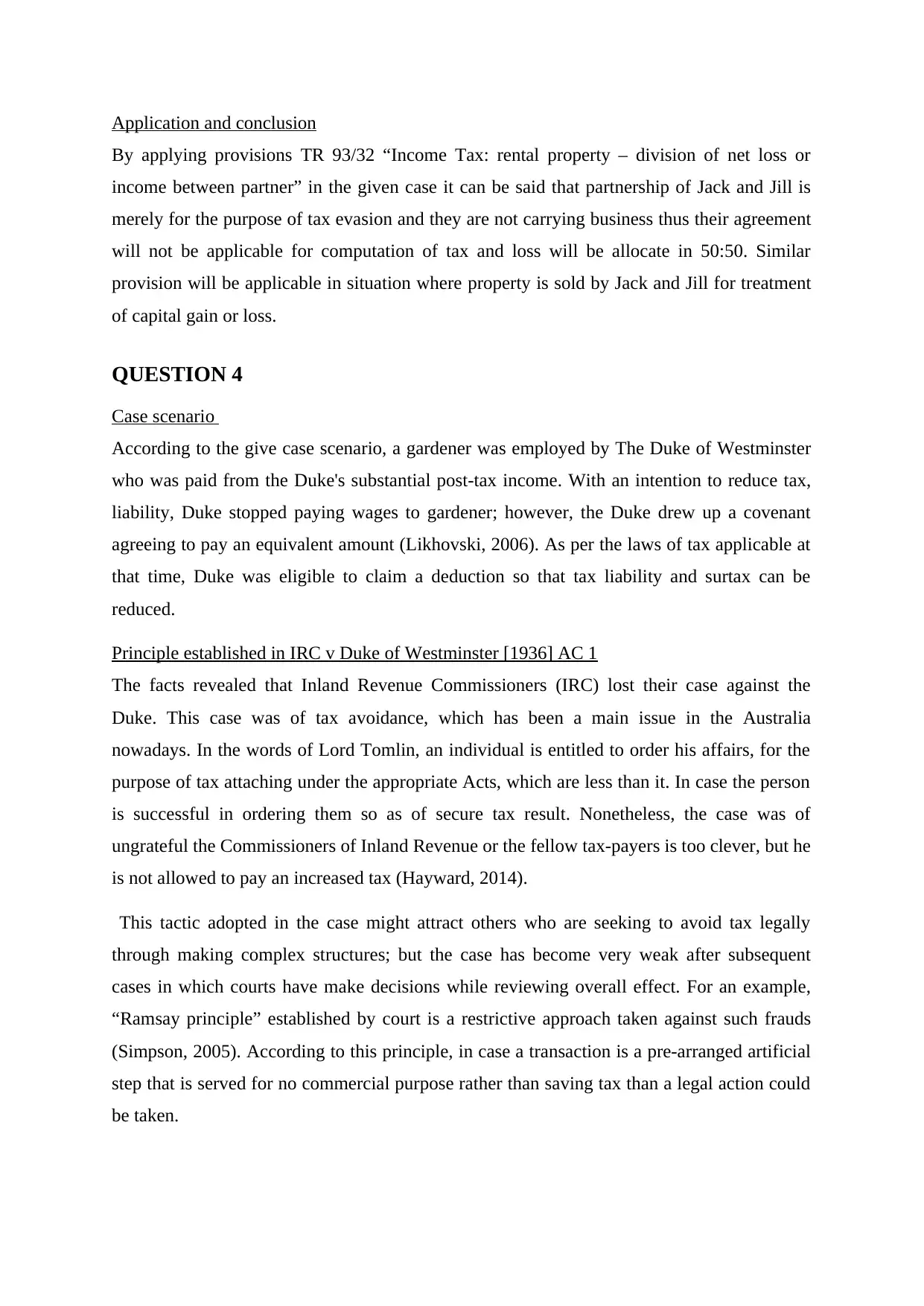
Application and conclusion
By applying provisions TR 93/32 “Income Tax: rental property – division of net loss or
income between partner” in the given case it can be said that partnership of Jack and Jill is
merely for the purpose of tax evasion and they are not carrying business thus their agreement
will not be applicable for computation of tax and loss will be allocate in 50:50. Similar
provision will be applicable in situation where property is sold by Jack and Jill for treatment
of capital gain or loss.
QUESTION 4
Case scenario
According to the give case scenario, a gardener was employed by The Duke of Westminster
who was paid from the Duke's substantial post-tax income. With an intention to reduce tax,
liability, Duke stopped paying wages to gardener; however, the Duke drew up a covenant
agreeing to pay an equivalent amount (Likhovski, 2006). As per the laws of tax applicable at
that time, Duke was eligible to claim a deduction so that tax liability and surtax can be
reduced.
Principle established in IRC v Duke of Westminster [1936] AC 1
The facts revealed that Inland Revenue Commissioners (IRC) lost their case against the
Duke. This case was of tax avoidance, which has been a main issue in the Australia
nowadays. In the words of Lord Tomlin, an individual is entitled to order his affairs, for the
purpose of tax attaching under the appropriate Acts, which are less than it. In case the person
is successful in ordering them so as of secure tax result. Nonetheless, the case was of
ungrateful the Commissioners of Inland Revenue or the fellow tax-payers is too clever, but he
is not allowed to pay an increased tax (Hayward, 2014).
This tactic adopted in the case might attract others who are seeking to avoid tax legally
through making complex structures; but the case has become very weak after subsequent
cases in which courts have make decisions while reviewing overall effect. For an example,
“Ramsay principle” established by court is a restrictive approach taken against such frauds
(Simpson, 2005). According to this principle, in case a transaction is a pre-arranged artificial
step that is served for no commercial purpose rather than saving tax than a legal action could
be taken.
By applying provisions TR 93/32 “Income Tax: rental property – division of net loss or
income between partner” in the given case it can be said that partnership of Jack and Jill is
merely for the purpose of tax evasion and they are not carrying business thus their agreement
will not be applicable for computation of tax and loss will be allocate in 50:50. Similar
provision will be applicable in situation where property is sold by Jack and Jill for treatment
of capital gain or loss.
QUESTION 4
Case scenario
According to the give case scenario, a gardener was employed by The Duke of Westminster
who was paid from the Duke's substantial post-tax income. With an intention to reduce tax,
liability, Duke stopped paying wages to gardener; however, the Duke drew up a covenant
agreeing to pay an equivalent amount (Likhovski, 2006). As per the laws of tax applicable at
that time, Duke was eligible to claim a deduction so that tax liability and surtax can be
reduced.
Principle established in IRC v Duke of Westminster [1936] AC 1
The facts revealed that Inland Revenue Commissioners (IRC) lost their case against the
Duke. This case was of tax avoidance, which has been a main issue in the Australia
nowadays. In the words of Lord Tomlin, an individual is entitled to order his affairs, for the
purpose of tax attaching under the appropriate Acts, which are less than it. In case the person
is successful in ordering them so as of secure tax result. Nonetheless, the case was of
ungrateful the Commissioners of Inland Revenue or the fellow tax-payers is too clever, but he
is not allowed to pay an increased tax (Hayward, 2014).
This tactic adopted in the case might attract others who are seeking to avoid tax legally
through making complex structures; but the case has become very weak after subsequent
cases in which courts have make decisions while reviewing overall effect. For an example,
“Ramsay principle” established by court is a restrictive approach taken against such frauds
(Simpson, 2005). According to this principle, in case a transaction is a pre-arranged artificial
step that is served for no commercial purpose rather than saving tax than a legal action could
be taken.
⊘ This is a preview!⊘
Do you want full access?
Subscribe today to unlock all pages.

Trusted by 1+ million students worldwide
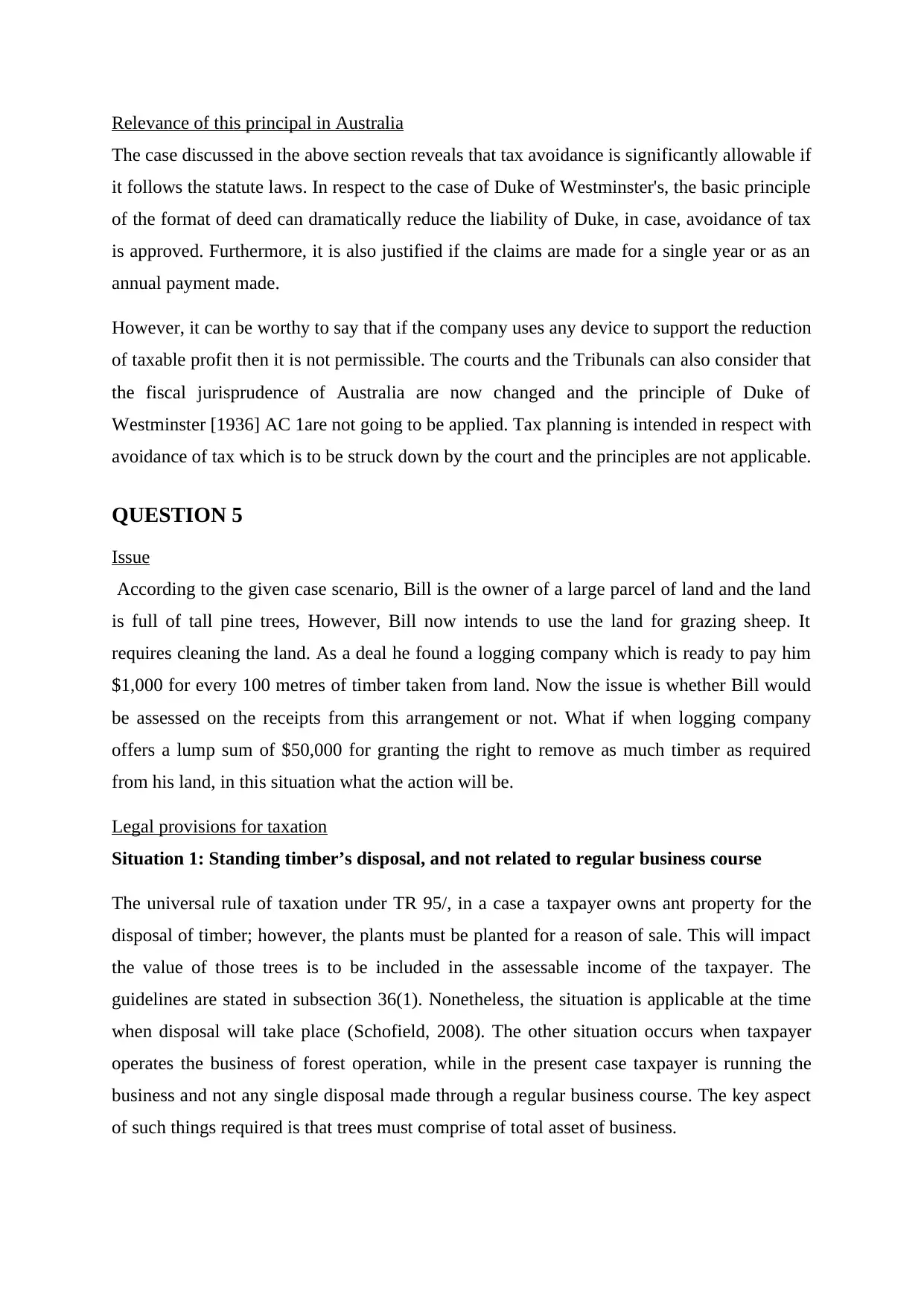
Relevance of this principal in Australia
The case discussed in the above section reveals that tax avoidance is significantly allowable if
it follows the statute laws. In respect to the case of Duke of Westminster's, the basic principle
of the format of deed can dramatically reduce the liability of Duke, in case, avoidance of tax
is approved. Furthermore, it is also justified if the claims are made for a single year or as an
annual payment made.
However, it can be worthy to say that if the company uses any device to support the reduction
of taxable profit then it is not permissible. The courts and the Tribunals can also consider that
the fiscal jurisprudence of Australia are now changed and the principle of Duke of
Westminster [1936] AC 1are not going to be applied. Tax planning is intended in respect with
avoidance of tax which is to be struck down by the court and the principles are not applicable.
QUESTION 5
Issue
According to the given case scenario, Bill is the owner of a large parcel of land and the land
is full of tall pine trees, However, Bill now intends to use the land for grazing sheep. It
requires cleaning the land. As a deal he found a logging company which is ready to pay him
$1,000 for every 100 metres of timber taken from land. Now the issue is whether Bill would
be assessed on the receipts from this arrangement or not. What if when logging company
offers a lump sum of $50,000 for granting the right to remove as much timber as required
from his land, in this situation what the action will be.
Legal provisions for taxation
Situation 1: Standing timber’s disposal, and not related to regular business course
The universal rule of taxation under TR 95/, in a case a taxpayer owns ant property for the
disposal of timber; however, the plants must be planted for a reason of sale. This will impact
the value of those trees is to be included in the assessable income of the taxpayer. The
guidelines are stated in subsection 36(1). Nonetheless, the situation is applicable at the time
when disposal will take place (Schofield, 2008). The other situation occurs when taxpayer
operates the business of forest operation, while in the present case taxpayer is running the
business and not any single disposal made through a regular business course. The key aspect
of such things required is that trees must comprise of total asset of business.
The case discussed in the above section reveals that tax avoidance is significantly allowable if
it follows the statute laws. In respect to the case of Duke of Westminster's, the basic principle
of the format of deed can dramatically reduce the liability of Duke, in case, avoidance of tax
is approved. Furthermore, it is also justified if the claims are made for a single year or as an
annual payment made.
However, it can be worthy to say that if the company uses any device to support the reduction
of taxable profit then it is not permissible. The courts and the Tribunals can also consider that
the fiscal jurisprudence of Australia are now changed and the principle of Duke of
Westminster [1936] AC 1are not going to be applied. Tax planning is intended in respect with
avoidance of tax which is to be struck down by the court and the principles are not applicable.
QUESTION 5
Issue
According to the given case scenario, Bill is the owner of a large parcel of land and the land
is full of tall pine trees, However, Bill now intends to use the land for grazing sheep. It
requires cleaning the land. As a deal he found a logging company which is ready to pay him
$1,000 for every 100 metres of timber taken from land. Now the issue is whether Bill would
be assessed on the receipts from this arrangement or not. What if when logging company
offers a lump sum of $50,000 for granting the right to remove as much timber as required
from his land, in this situation what the action will be.
Legal provisions for taxation
Situation 1: Standing timber’s disposal, and not related to regular business course
The universal rule of taxation under TR 95/, in a case a taxpayer owns ant property for the
disposal of timber; however, the plants must be planted for a reason of sale. This will impact
the value of those trees is to be included in the assessable income of the taxpayer. The
guidelines are stated in subsection 36(1). Nonetheless, the situation is applicable at the time
when disposal will take place (Schofield, 2008). The other situation occurs when taxpayer
operates the business of forest operation, while in the present case taxpayer is running the
business and not any single disposal made through a regular business course. The key aspect
of such things required is that trees must comprise of total asset of business.
Paraphrase This Document
Need a fresh take? Get an instant paraphrase of this document with our AI Paraphraser
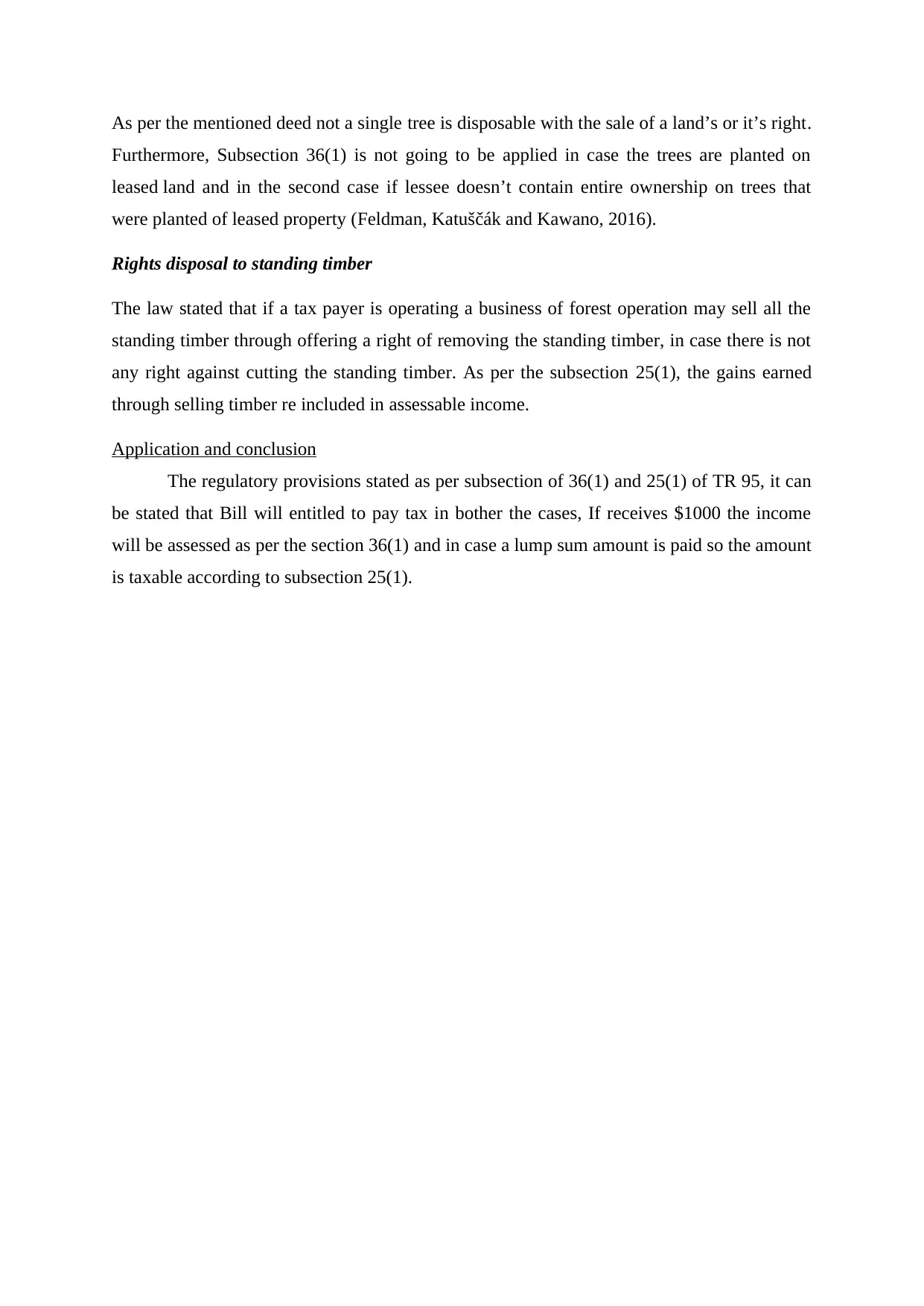
As per the mentioned deed not a single tree is disposable with the sale of a land’s or it’s right.
Furthermore, Subsection 36(1) is not going to be applied in case the trees are planted on
leased land and in the second case if lessee doesn’t contain entire ownership on trees that
were planted of leased property (Feldman, Katuščák and Kawano, 2016).
Rights disposal to standing timber
The law stated that if a tax payer is operating a business of forest operation may sell all the
standing timber through offering a right of removing the standing timber, in case there is not
any right against cutting the standing timber. As per the subsection 25(1), the gains earned
through selling timber re included in assessable income.
Application and conclusion
The regulatory provisions stated as per subsection of 36(1) and 25(1) of TR 95, it can
be stated that Bill will entitled to pay tax in bother the cases, If receives $1000 the income
will be assessed as per the section 36(1) and in case a lump sum amount is paid so the amount
is taxable according to subsection 25(1).
Furthermore, Subsection 36(1) is not going to be applied in case the trees are planted on
leased land and in the second case if lessee doesn’t contain entire ownership on trees that
were planted of leased property (Feldman, Katuščák and Kawano, 2016).
Rights disposal to standing timber
The law stated that if a tax payer is operating a business of forest operation may sell all the
standing timber through offering a right of removing the standing timber, in case there is not
any right against cutting the standing timber. As per the subsection 25(1), the gains earned
through selling timber re included in assessable income.
Application and conclusion
The regulatory provisions stated as per subsection of 36(1) and 25(1) of TR 95, it can
be stated that Bill will entitled to pay tax in bother the cases, If receives $1000 the income
will be assessed as per the section 36(1) and in case a lump sum amount is paid so the amount
is taxable according to subsection 25(1).
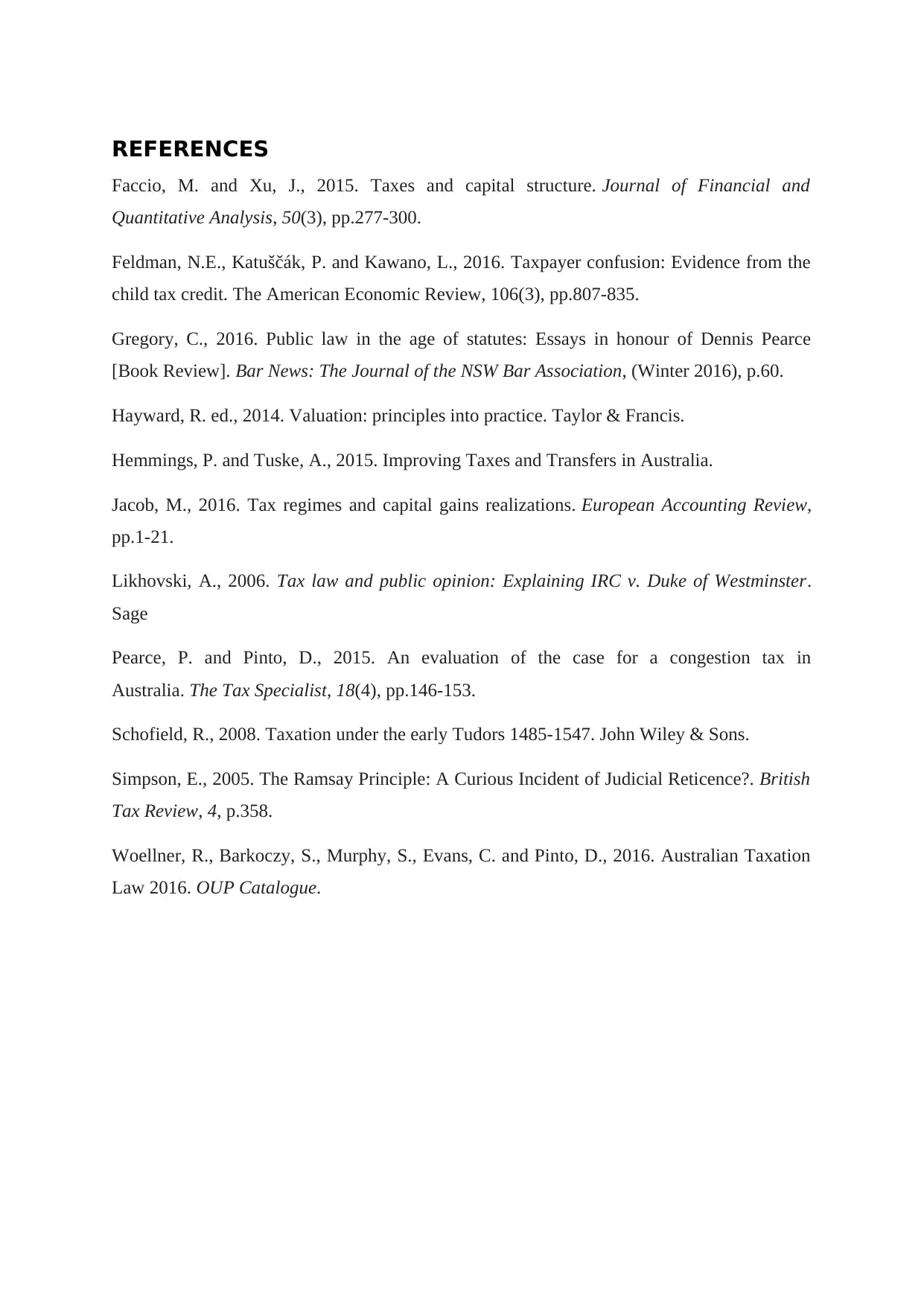
REFERENCES
Faccio, M. and Xu, J., 2015. Taxes and capital structure. Journal of Financial and
Quantitative Analysis, 50(3), pp.277-300.
Feldman, N.E., Katuščák, P. and Kawano, L., 2016. Taxpayer confusion: Evidence from the
child tax credit. The American Economic Review, 106(3), pp.807-835.
Gregory, C., 2016. Public law in the age of statutes: Essays in honour of Dennis Pearce
[Book Review]. Bar News: The Journal of the NSW Bar Association, (Winter 2016), p.60.
Hayward, R. ed., 2014. Valuation: principles into practice. Taylor & Francis.
Hemmings, P. and Tuske, A., 2015. Improving Taxes and Transfers in Australia.
Jacob, M., 2016. Tax regimes and capital gains realizations. European Accounting Review,
pp.1-21.
Likhovski, A., 2006. Tax law and public opinion: Explaining IRC v. Duke of Westminster.
Sage
Pearce, P. and Pinto, D., 2015. An evaluation of the case for a congestion tax in
Australia. The Tax Specialist, 18(4), pp.146-153.
Schofield, R., 2008. Taxation under the early Tudors 1485-1547. John Wiley & Sons.
Simpson, E., 2005. The Ramsay Principle: A Curious Incident of Judicial Reticence?. British
Tax Review, 4, p.358.
Woellner, R., Barkoczy, S., Murphy, S., Evans, C. and Pinto, D., 2016. Australian Taxation
Law 2016. OUP Catalogue.
Faccio, M. and Xu, J., 2015. Taxes and capital structure. Journal of Financial and
Quantitative Analysis, 50(3), pp.277-300.
Feldman, N.E., Katuščák, P. and Kawano, L., 2016. Taxpayer confusion: Evidence from the
child tax credit. The American Economic Review, 106(3), pp.807-835.
Gregory, C., 2016. Public law in the age of statutes: Essays in honour of Dennis Pearce
[Book Review]. Bar News: The Journal of the NSW Bar Association, (Winter 2016), p.60.
Hayward, R. ed., 2014. Valuation: principles into practice. Taylor & Francis.
Hemmings, P. and Tuske, A., 2015. Improving Taxes and Transfers in Australia.
Jacob, M., 2016. Tax regimes and capital gains realizations. European Accounting Review,
pp.1-21.
Likhovski, A., 2006. Tax law and public opinion: Explaining IRC v. Duke of Westminster.
Sage
Pearce, P. and Pinto, D., 2015. An evaluation of the case for a congestion tax in
Australia. The Tax Specialist, 18(4), pp.146-153.
Schofield, R., 2008. Taxation under the early Tudors 1485-1547. John Wiley & Sons.
Simpson, E., 2005. The Ramsay Principle: A Curious Incident of Judicial Reticence?. British
Tax Review, 4, p.358.
Woellner, R., Barkoczy, S., Murphy, S., Evans, C. and Pinto, D., 2016. Australian Taxation
Law 2016. OUP Catalogue.
⊘ This is a preview!⊘
Do you want full access?
Subscribe today to unlock all pages.

Trusted by 1+ million students worldwide
1 out of 9
Related Documents
Your All-in-One AI-Powered Toolkit for Academic Success.
+13062052269
info@desklib.com
Available 24*7 on WhatsApp / Email
![[object Object]](/_next/static/media/star-bottom.7253800d.svg)
Unlock your academic potential
Copyright © 2020–2025 A2Z Services. All Rights Reserved. Developed and managed by ZUCOL.





